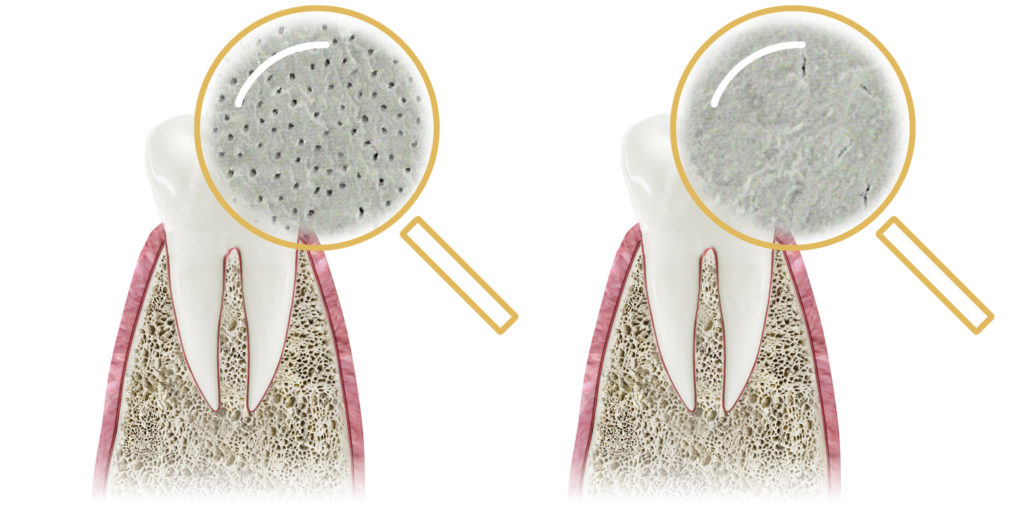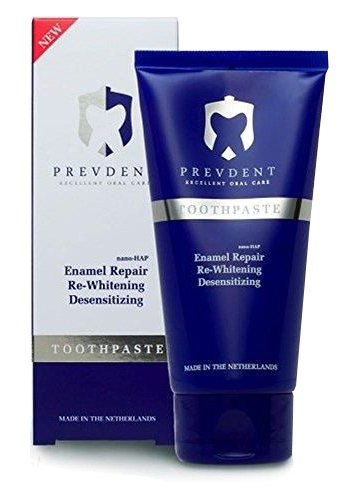Basic information about teeth whitening

teeth WHITENING
Whitening – the basic procedure of cosmetic dentistry
Teeth whitening is one of the most frequently performed treatments in cosmetic dentistry. People with a beautiful, white smile are perceived as healthier and more attractive, but only few are satisfied with their natural colour of enamel. There are various causes of teeth discolouration. Enamel darkening may result from genetic predisposition, abnormal tooth development or side effects of antibiotics used in childhood. Other factors that have major impact on the colour of teeth include smoking and consumption of products containing highly coloured substances (such as coffee, tea, wine). Professional teeth whitening treatment is a wonderful, quick and painless route to beautiful white teeth for all ages.
Teeth whitening treatment is intended for anyone who is not happy with the colour of their teeth.
PREVDENT whitening
PREVDENT teeth whitening and enamel repair
Prevdent is a state-of-the-art whitening system that enables enamel regeneration and strengthening while whitening teeth.

TOOTH SURFACE BEFORE TREATMENT VS TOOTH SURFACE AFTER TREATMENT
Teeth whitening using the Prevdent method involves the use of technologically advanced ingredients such as:
- nano-hydroxyapatite – an artificially created equivalent of hydroxyapatite (the main component of the enamel), which penetrates and remineralises the enamel surface and eliminates tooth hypersensitivity.
- low concentration, 6% hydrogen peroxide – active whitening substance that brightens the colour of teeth by up to 7–8 shades in less than 3 hours.
- “Stain Removal” – an advanced combination of surfactants, detergents, solvents and active oxygen that penetrates deep into the teeth to break down and remove stains.
Anyone can benefit from the procedure carried out by a certified dental hygienist as long as there are no contraindications from a doctor. It is especially recommended for people with teeth hypersensitivity.
The advantages of Prevdent whitening:

Stages of the Prevdent procedure:

| The whitening effect can last from 2–3 years (depending on the individual predisposition of the patient and eating habits). In order to prolong the results, Prevdent products are recommended. |  |

prevdent lamp
Other methods of teeth whitening
Instant whitening with the Beyond Polus Advanced accelerator
Instant whitening with Beyond Polus Advanced combines innovation, safety and maximum effects in professional teeth whitening. Thanks to the use of innovative cold light technology, i.e., a combination of halogen and diode lights, which thanks to numerous optical fibres and a special optical system eliminates harmful ultraviolet (UV) and infrared radiation (IR), the tooth does not overheat, which prevents further unwanted effects. The main advantage of this method is its very high efficiency. Teeth can brighten considerably during a single visit.
The whitening procedure must be preceded by professional oral hygiene (removal of calculus and plaque).

Beyond Polus Advanced Accelerator WHITENs TEETH DURING 3, 15-MINUTES SESSIONS
The whitening treatment is not complicated and does not take long (less than 45 minutes). There is no reason to be afraid of irritation during and after the treatment, because the Beyond lamp does not produce harmful UV radiation or generate heat. The treatment is completely painless.
The whitening treatment is carried out by a certified dental hygienist under the supervision of a dentist and proceeds according to the following plan:
- Evaluation of the output colour of the teeth using the SpectroShade device and determination of the expected final effect after the procedure.
- Preparing the patient for the procedure: putting on protective goggles, applying a special dental retractor and securing the gums with a liquid resin (so-called cofferdam) hardened with a polymerisation lamp.
- Application of whitening gel for teeth.
- Exposure of the Beyond Polus Advanced lamp directly on the teeth. Standard whitening includes three exposures, but after the effect is checked after each one.
- Checking the colour of teeth and making further recommendations.
Tray-based teeth whitening
Tray-based teeth whitening is the whitening of teeth at home with the help of special whitening trays. This method gives a long-lasting effect of a snow-white smile and can brighten teeth by several shades within 8 days. The effect is visible after the first application.
This method involves taking an impression of the maxilla and mandible and preparing a special, individualised tray on this basis. The patient then applies a whitening gel with the right concentration to the tray and wears it for the next 8 nights. After the treatment, the teeth are brightened by as much as several shades. The teeth brightening effect is obtained after the first night.

TRAY whitening
Whitening of a dead tooth
Whitening of a dead tooth – applicable to teeth with internal discolouration resulting from inaccurate removal of bleeding pulp during root canal treatment.
Whitening of a dead tooth begins by re-opening and processing the tooth cavity. A special preparation for whitening dead teeth is placed inside the tooth crown, and the hole is closed with a temporary dressing – a flipper. After finishing the whitening, the tooth cavity is closed, and a typical composite filling is put on.

dead tooth whitening procedure
Recommendations after teeth whitening procedure – instructions for the patient
To be able to enjoy the effect of whitening throughout life, it is necessary to strictly follow the recommendations after the procedure and to comply with a white diet. Over time, the teeth may slightly change their colour. It is enough to use a whitening refreshment treatment. It may also be helpful to sandblast your teeth or use a whitening toothpaste.
A white diet is necessary so as not to spoil the effect of whitening teeth immediately after the procedure. The best products are white cheese, yogurt, buttermilk, rice, potatoes or pasta. Because the whitening gel temporarily increases the porosity of the enamel (teeth behave like a sponge), which leads to a significant susceptibility of teeth to colourants, consumption of such products as: beetroot, juices, sauces (they colour teeth), red wine, colourful vegetables and fruits is not recommended.
![]() In the case of Prevdent whitening, the white diet is required only 24 hours – this is adventage of the nano-hydroxyapatite used in this method, which minimizes the porosity of the enamel, protecting it against the influence of any dyes found in food.
In the case of Prevdent whitening, the white diet is required only 24 hours – this is adventage of the nano-hydroxyapatite used in this method, which minimizes the porosity of the enamel, protecting it against the influence of any dyes found in food.
Frequently asked questions
My teeth are yellow, there are numerous discolourations. What can I do?
It’s worth beginning with sandblasting and brushing your teeth with whitening pastes. For people over sixteen years old, a good solution is teeth whitening, which effectively changes the colour of the enamel to a lighter shade.
What are the recommendations after tooth whitening?
In the first few days after the procedure the teeth are particularly exposed to discolouration. The most important thing is to use a so-called “white diet” for at least 7 days after whitening, because the colour stabilisation lasts about 14 days. This means that the patient should completely give up products that could colour the teeth. You should refrain from consuming: coffee, tea, red wine, beetroot, fruit juice, cola etc. It is also forbidden to smoke cigarettes for at least two days. Teeth may be slightly more sensitive than usual, so be especially careful when consuming hot and cold foods and beverages.
Does whitening weaken teeth?
Whitening, if it is done in a professional dental office, will not negatively affect the condition of the teeth. There are numerous studies and publications proving that this procedure is completely safe for enamel.
Is it possible to whiten artificial teeth?
No, only natural teeth can be whitened. When choosing natural whitening, it is also a good idea to replace existing artificial teeth with new, brighter ones, so that their colour does not clash with the colour of newly whitened natural teeth.
Why shouldn’t under-16s whiten their teeth?
Since the process of tooth mineralisation continues until age 16, whitening is not recommended beforehand.
Can anyone undergo the Beyond Polus whitening treatment?
Beyond Polus is designed for every patient. It is most effective in patients whose discolouration was caused by eating coloured food and smoking cigarettes. This treatment is also effective for teeth with tetracycline and fluorosis discolourations and discolouration resulting from the patient’s age.
How much whiter will my teeth be after whitening?
The effect of whitening is an individual matter, depending largely on the intensity and source of discolouration. The final colour is fixed 7-14 days after the procedure, while the effect depends on following the post-treatment instructions.
We start whitening by checking the initial colour of the teeth. Using the SpectroShade device, we take several pictures of the teeth, so that we can then compare their colour before and after the procedure. Fillings, veneers and prosthetic crowns are not bleached and retain their colour. Therefore, old fillings or crowns should be replaced 2 weeks after tooth whitening.
I have one very dark tooth. It is dead. How can I whiten it?
After canal treatment, whitening dead teeth requires a separate procedure. Discolourations in such teeth are formed by the penetration of blood dyes, dead pulp (nerves) of the tooth and material filling of the older generation canal into the dentine. This process takes place inside the tooth, and so it should be treated with a bleaching agent from the inside. Bleaching such a tooth involves accessing its chamber and inserting a bleaching preparation. This insert is replaced every few days. Treatment includes 2 to 4 visits depending on the degree of discolouration of the crown. On the last visit, a colour-adapted composite filling is inserted.
Are there any contraindications for whitening?
Unfortunately, not all patients can benefit from tooth whitening.
The following groups should avoid whitening:
• pregnant and breast-feeding women
• people with epilepsy or Parkinson’s disease
• people with very intense dental hypersensitivity
• opeople who are under 16 years old
• people with allergies or hypersensitivity to oxidants, glycerol and polyacrylic resin
Before the whitening procedure, it is important to treat the following:
- carious cavities
- inflammatory conditions within the oral cavity
Is it necessary to conduct an oral cavity hygiene treatment before whitening?
Definitely yes. Performing full oral hygiene treatment helps guarantee the success of whitening, because teeth with impurities on them will not whiten.










